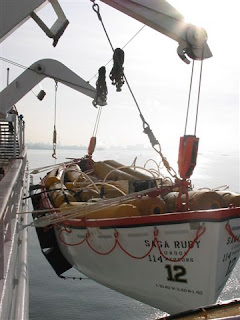Following are important points pertaining to maintenance and tests on lifeboats. For information and discussion purposes only.
Responsibility
6 The company*
is responsible for servicing and maintenance on board its ships in
accordance with SOLAS regulation III/20 and for the establishment and implementation of health, safety and environment (HSE) procedures covering all activities during servicing and maintenance.
7 The personnel carrying out servicing and maintenance are responsible for the performance of the work as authorized in accordance with the system specified in paragraph 10.
8 The above personnel are also responsible for complying with HSE instructions and procedures.
9 Service providers carrying out the thorough examination, operational testing, repair and overhaul of lifeboats, launching appliances and on-load release gear should be authorized in accordance with MSC.1/Circ.1277.
Notes:
1 The setting and maintenance of release gear are critical operations with
regard to maintaining the safe operation of the lifeboat and the safety of
personnel in the lifeboat. All inspection and maintenance operations on
this equipment should therefore be carried out with the utmost care.
2 No maintenance or adjustment of the release gear should be undertaken
while the hooks are under load.
3 Hanging-off pennants may be used for this purpose but should not remain
connected at other times, such as when the lifeboat is normally stowed and
during training exercises.
4 The release gear is to be examined prior to its operational test.
The release gear is to be re-examined after its operational test and the dynamic winch
brake test.
Special consideration should be given to ensure that no damage has occurred during the winch brake test, especially the hook fastening.
2.6 Operational test of off-load release function:
.1 position the lifeboat fully waterborne;
.2 operate the off-load release gear;
.3 reset the on-load release gear; and
.4 recover the lifeboat to the stowed position and prepare for operational readiness.
Note:
Prior to hoisting, check that the release gear is completely and properly reset. The final turning-in of the lifeboat should be done without any persons on board.
2.7 Operational test of free-fall lifeboat release function:
.1 engage the simulated launching arrangements as specified in the manufacturer’s operating instructions;
.2 the operator should be properly seated and secured in the seat location from which the release mechanism is to be operated;
.3 operate the release mechanism to release the lifeboat;
.4 reset the lifeboat in the stowed configuration;
.5 repeat procedures referred to in .2 to .4 above, using the back-up release mechanism, when applicable;
.6 remove the simulated launching arrangements; and
.7 verify that the lifeboat is in the ready to launch stowed configuration.
3 DYNAMIC WINCH BRAKE TEST
3.1 Annual operational testing should preferably be done by lowering the empty boat. When
the boat has reached its maximum lowering speed and before the boat enters the water, the brake
should be abruptly applied.
3.2 The five-year operational test should be done by lowering the boat loaded to a proof load
equal to 1.1 times the weight of the survival craft or rescue boat and its full complement of
persons and equipment, or equivalent load. When the boat has reached its maximum lowering
speed and before the boat enters the water, the brake should be abruptly applied.
3.3 Following these tests, the brake pads and stressed structural parts should be re-inspected.
Note:
In loading the boat for this test, precautions should be taken to ensure that the stability of the
boat is not adversely affected by free surface effects or the raising of the centre of gravity.
4 OVERHAUL OF ON-LOAD RELEASE GEAR
Overhaul of on-load release gear includes:
.1 dismantling of hook release units;
.2 examination with regard to tolerances and design requirements;
.3 adjustment of release gear system after assembly;
.4 operational test as per above and with a load according to SOLAS regulation III/20.11.2.3;
and
.5 examination of vital parts with regard to defects and cracks.
Note:
Non-destructive examination (NDE) techniques, such as dye penetrants (DPE),
may be suitable.
2 Purpose and scope
The purpose of these Guidelines is to provide a basic outline of essential steps to safely carry out simulated launching. These Guidelines are general; the lifeboat manufacturer’s instruction manual should always be consulted before conducting simulated launching. Simulated launching should only be carried out with lifeboats and launching appliances designed to accommodate it, and for which the manufacturer has provided instructions. Simulated launching should be carried out under the supervision of a responsible person who should be an officer experienced in such procedures.


Hi Jim,
ReplyDeleteThanks for above!
What do you think about :
Annual operational testing should preferably be done by lowering the empty boat. When
the boat has reached its maximum lowering speed and before the boat enters the water, the brake
should be abruptly applied
is it really the right test?